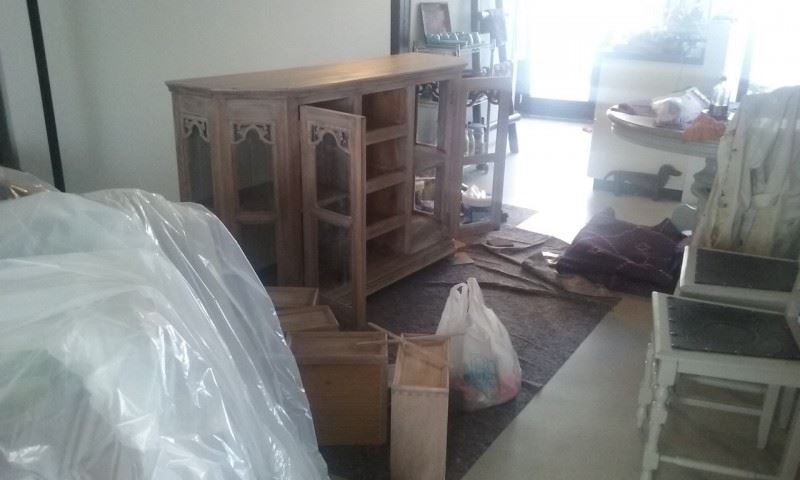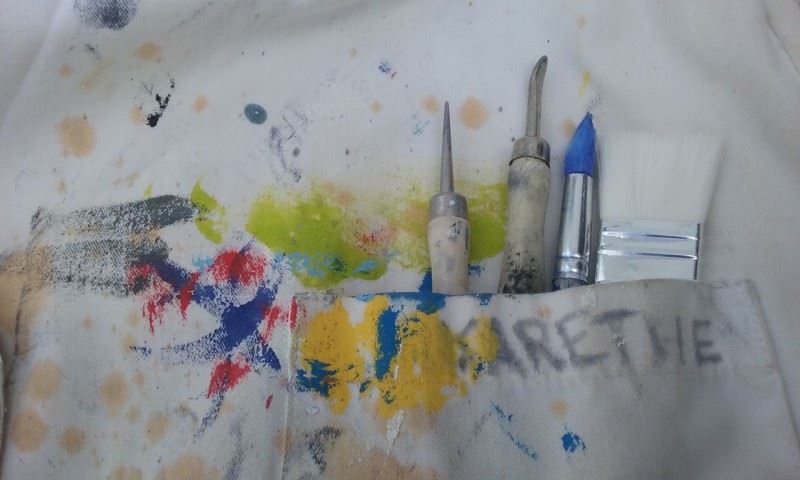
My husband, bless his heart, has often bemoaned his wife’s lack of skills and interest in the cooking department. To be just, he is absolutely right. I am not a cook. He was taught to cook by his Basque mother and received chef training in Continental and Asian cuisine. He knows exactly how to slice every vegetable and what direction to cut the meat. I was not taught to cook, as it was never considered it an essential life-skill in my house. Like my mother, I prefer reading, writing and cultural pursuits. Like my father, I love tinkering, which is how I caught my restoration-bug.
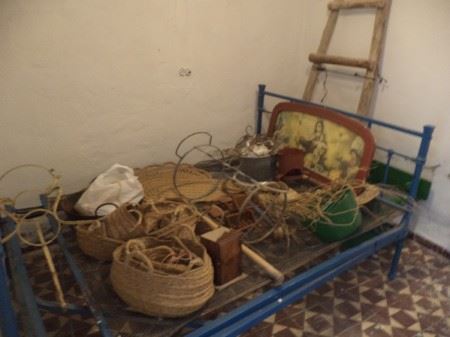
In our family, my husband generally cooks while I do the clean up. A fair deal, if you ask me. It is not that I do not appreciate a good meal. I just believe that just as there need to be people who do the cooking, there also have to be eaters to compliment them. The other day I ventured to make a stir-fry-ish kind of dish. My husband ate without complaint, though he did point out that when using black bean sauce one ought not to use copious amounts of ginger, which overpowers all. I see his logic, not from a food point of view mind you, but from a colour perspective. Too much of one colour or not enough, or the wrong blend may have disastrous effects. Like spices, it is all in the mix. When my husband cooks something, I will say, “That looks nice and colourful!” “Never mind the look. How does it taste?” he will ask. Cooking and restoring are really quite similar. Either way, you end up with a big mess. In the former you have pots and pans, measuring spoons and other dishes. In the latter you have brushes, steel wool, glues and waxes.
Unfortunately, it is not only cooking I do poorly, it is also food shopping. Once a week my husband goes to his wood carving group and it is my turn to make lunch. I get busy writing or fixing something and forget the time. Minutes before my husband is due, I rush to the store, toss some eatables in a bag and dash home to start chopping, hoping to have something in the pan before he comes in the door. He will ask me what I am cooking. “Oh, I don’t know”, I’ll say. “But how can you start cooking, if you don’t have a plan?” he asks. Things are certainly easier for us non-cooks in the summer, when one can just whip up a salad (I can do that!) and throw some meat in the pan. More times than not, it ends up like carbon. I over-boil, under-cook or burn to a crisp, just as surely as some people sing out of tune or dress like a piñata. I might as well admit it. My art lies elsewhere…
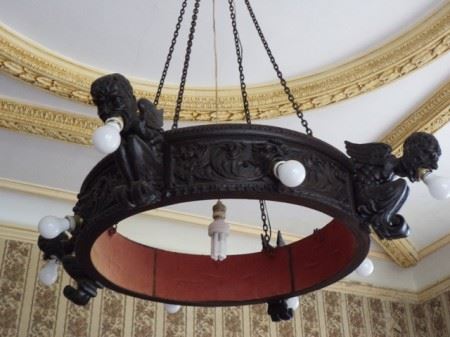 Our hometown Ronda has long been known for its rondeña furniture, recognized by its woodcarvings. Most locals have a rondeña chair or cupboard, usually carved by an old relative. The styles vary from simple farm furniture with minor engravings to elaborately carved pieces. In Ronda’s Santa Maria Major church, the choir section is carved in an ornate Plateresque fashion. The Casa Don Bosco museum has some very curious carvings, such as a wooden chandelier of human heads with mouths holding onto the bulbs. Somewhat risqué for a home of a priest, wouldn’t you say?For our home in Ronda, we wanted to restore a few salvageable pieces from the original house (read ruin…). We both liked the unpretentious Andalucian farm furniture, which with luck one still can find for sale around here. However, we both felt that the traditional brown stains would not suit our style. Dark wood and dragons carvings have their place, but us Scandinavians usually favour lighter woods and colours. All our salvaged, purchased and donated furniture I transformed with scrapers, paints, tints and waxes. Each piece got a different treatment, though our home can generally be described as a Nordic Shabby Chic with the occasional Mexican or Tibetan colour-splash.
Our hometown Ronda has long been known for its rondeña furniture, recognized by its woodcarvings. Most locals have a rondeña chair or cupboard, usually carved by an old relative. The styles vary from simple farm furniture with minor engravings to elaborately carved pieces. In Ronda’s Santa Maria Major church, the choir section is carved in an ornate Plateresque fashion. The Casa Don Bosco museum has some very curious carvings, such as a wooden chandelier of human heads with mouths holding onto the bulbs. Somewhat risqué for a home of a priest, wouldn’t you say?For our home in Ronda, we wanted to restore a few salvageable pieces from the original house (read ruin…). We both liked the unpretentious Andalucian farm furniture, which with luck one still can find for sale around here. However, we both felt that the traditional brown stains would not suit our style. Dark wood and dragons carvings have their place, but us Scandinavians usually favour lighter woods and colours. All our salvaged, purchased and donated furniture I transformed with scrapers, paints, tints and waxes. Each piece got a different treatment, though our home can generally be described as a Nordic Shabby Chic with the occasional Mexican or Tibetan colour-splash.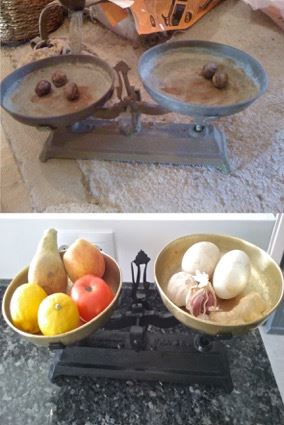 My first project for the house was four chairs bought from a fellow restoration student. They had fabulous art nouveaux embossed leather seats and backs, possibly made by a Cordoba artist, as the city was known for this type of leather embossment. The leather was covered in globs of black paint and unsightly glossy varnish. I carefully cleaned it with ultra fine steel wool and a diluted paint stripper and miraculously they survived the treatment. The wood had so many layers of lacquered that they were probably the sole reason why the chairs still hung together. Copious amounts of bug killer and then wood filler was needed, as they were too frail and worm infested to leave in their natural state. I painted them in a light vintage pewter colour, which I painstakingly got a local paint store to reproduce, giving the employee the most demanding task of his entire career…The next restoration piece was donated by one of my husband’s patient. She wanted to thank him by offered me to pick up a couple of restoration pieces from their country home. She knew that we had moved to Ronda without a stick of furniture and that I loved restoration. I immediately fell for a traditional old scale, which almost every Andalucian farmhouse seem to have. I took it home and gave it a major scrub. The iron base was beyond leaving ‘as is’, so I gave it a flat black metal paint finish. The two brass plates came out shining after scrubbing them with several plastic-mesh sponges and ample batches of boiling vinegar. This is a local restoration secret. It smells vile, but it does the job.
My first project for the house was four chairs bought from a fellow restoration student. They had fabulous art nouveaux embossed leather seats and backs, possibly made by a Cordoba artist, as the city was known for this type of leather embossment. The leather was covered in globs of black paint and unsightly glossy varnish. I carefully cleaned it with ultra fine steel wool and a diluted paint stripper and miraculously they survived the treatment. The wood had so many layers of lacquered that they were probably the sole reason why the chairs still hung together. Copious amounts of bug killer and then wood filler was needed, as they were too frail and worm infested to leave in their natural state. I painted them in a light vintage pewter colour, which I painstakingly got a local paint store to reproduce, giving the employee the most demanding task of his entire career…The next restoration piece was donated by one of my husband’s patient. She wanted to thank him by offered me to pick up a couple of restoration pieces from their country home. She knew that we had moved to Ronda without a stick of furniture and that I loved restoration. I immediately fell for a traditional old scale, which almost every Andalucian farmhouse seem to have. I took it home and gave it a major scrub. The iron base was beyond leaving ‘as is’, so I gave it a flat black metal paint finish. The two brass plates came out shining after scrubbing them with several plastic-mesh sponges and ample batches of boiling vinegar. This is a local restoration secret. It smells vile, but it does the job. Our bedside tables were also a gift. They were not true antique, probably utility furniture from the 50s. The side panels and back were cheap plywood and the drawers were nailed together, but once I removed the wooden decorative edging and scraped off endless layers of gooey brown varnish, I unearthed a nice top and drawer front, which could be sanded, treated and kept. All other surfaces were painted a pigeon blue chalk paint, then sanded and painted a layer of ‘hot chocolate’ chalk paint. (The latter is now available in Andalucía, though only on the coast.) After distressing and waxing it with white antique wax, they got a new home in our bedroom.
Our bedside tables were also a gift. They were not true antique, probably utility furniture from the 50s. The side panels and back were cheap plywood and the drawers were nailed together, but once I removed the wooden decorative edging and scraped off endless layers of gooey brown varnish, I unearthed a nice top and drawer front, which could be sanded, treated and kept. All other surfaces were painted a pigeon blue chalk paint, then sanded and painted a layer of ‘hot chocolate’ chalk paint. (The latter is now available in Andalucía, though only on the coast.) After distressing and waxing it with white antique wax, they got a new home in our bedroom. A very time-consuming and messy project was the hand-made farm ladder we found in the basement when we bought our house. The last human house resident, likely the blind lady who lived there until 1986, had left a Spanish ham hanging on one of the ladder’s side rails. There it had been rotting, slowly seeping its rancid grease over the lower rungs. Though it was tempting to throw out the whole contraption, I decided to double bag the ham and hose down the ladder to consider my options. I cannot count the hours spent scraping and sanding it. The wood was a nice silvery driftwood colour, but with all the worm canals, I had to give it too much wood filler to be able to leave it natural. I chose Bethún de Judea, which is an old style petroleum-based product used here, particularly to give patinaor accentuate crackling. It has a lovely deep wenge wood colour and works wonders for disguising imperfections in antiques.
A very time-consuming and messy project was the hand-made farm ladder we found in the basement when we bought our house. The last human house resident, likely the blind lady who lived there until 1986, had left a Spanish ham hanging on one of the ladder’s side rails. There it had been rotting, slowly seeping its rancid grease over the lower rungs. Though it was tempting to throw out the whole contraption, I decided to double bag the ham and hose down the ladder to consider my options. I cannot count the hours spent scraping and sanding it. The wood was a nice silvery driftwood colour, but with all the worm canals, I had to give it too much wood filler to be able to leave it natural. I chose Bethún de Judea, which is an old style petroleum-based product used here, particularly to give patinaor accentuate crackling. It has a lovely deep wenge wood colour and works wonders for disguising imperfections in antiques.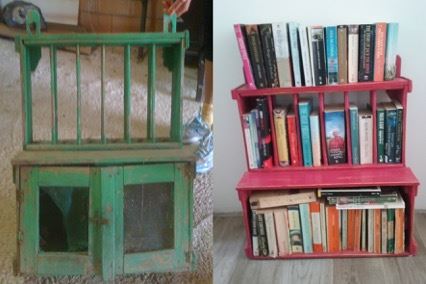 Aplaterois a Spanish plate-shelf. Most traditional farmhouses have, or at least used to have one. These days they are harder to find, (though IKEA has made a copy) and I was lucky to be given one by a fellow restoration enthusiast. It was in a sad state, barely hanging together, full of pigeon feathers and mice droppings. I tried to revive it in it’s entirety, but as I scraped off the iridescent green (keeping some in parts, as I liked the cheery effect), I realized that it would never be able to hold plates again. So with many hidden angle irons and various coats of honeyed yellow, then antique raspberry chalk paint, and finally a matte translucent varnish, it has now become a bookshelf for all the pocketbooks that friends have kindly left or lent us.
Aplaterois a Spanish plate-shelf. Most traditional farmhouses have, or at least used to have one. These days they are harder to find, (though IKEA has made a copy) and I was lucky to be given one by a fellow restoration enthusiast. It was in a sad state, barely hanging together, full of pigeon feathers and mice droppings. I tried to revive it in it’s entirety, but as I scraped off the iridescent green (keeping some in parts, as I liked the cheery effect), I realized that it would never be able to hold plates again. So with many hidden angle irons and various coats of honeyed yellow, then antique raspberry chalk paint, and finally a matte translucent varnish, it has now become a bookshelf for all the pocketbooks that friends have kindly left or lent us.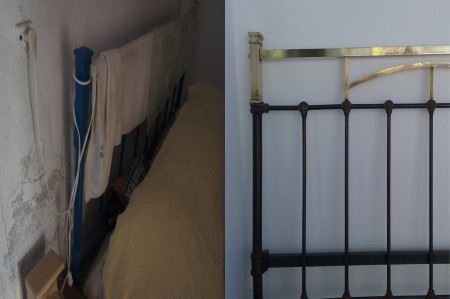 Did I say that restoration is a labour of love? One cannot repeat this enough, in case someone gets the foolish notion that restoring is a quick and easy option to buying new. It isn’t! It is fun if one loves seeing things being transformed, if one is stupidly stubborn, if one has no objection to nit-picky work and is prepared to spend endless amounts of elbow grease. Take our headboard. We found the bed in the old house covered in layers to blue paint, which removal nearly killed me. Metal is not as forgiving as wood which can be sanded over. Our bed was an old heavy iron frame with a decorative brass top piece. For days I was on my knees with a sharp picker tool, scraping microscopic pieces of paint off the iron fleur-de-lis welding points, feeling like a dental assistant. My restoration mates joined my husband thinking I had lost my mind. They suggested just painting the darn thing black. But I love exposed iron and would not give in. Once it was cleaned, I set to work on the brass top, using the Andalucian natural metal polish, boiling vinegar. I had no fingers left, but finally, after a quick rubdown with olive oil, the headboard came home. And what did I start on the following week, but the footboard! (It will eventually be the back of a bench on our upper terrace.)
Did I say that restoration is a labour of love? One cannot repeat this enough, in case someone gets the foolish notion that restoring is a quick and easy option to buying new. It isn’t! It is fun if one loves seeing things being transformed, if one is stupidly stubborn, if one has no objection to nit-picky work and is prepared to spend endless amounts of elbow grease. Take our headboard. We found the bed in the old house covered in layers to blue paint, which removal nearly killed me. Metal is not as forgiving as wood which can be sanded over. Our bed was an old heavy iron frame with a decorative brass top piece. For days I was on my knees with a sharp picker tool, scraping microscopic pieces of paint off the iron fleur-de-lis welding points, feeling like a dental assistant. My restoration mates joined my husband thinking I had lost my mind. They suggested just painting the darn thing black. But I love exposed iron and would not give in. Once it was cleaned, I set to work on the brass top, using the Andalucian natural metal polish, boiling vinegar. I had no fingers left, but finally, after a quick rubdown with olive oil, the headboard came home. And what did I start on the following week, but the footboard! (It will eventually be the back of a bench on our upper terrace.)
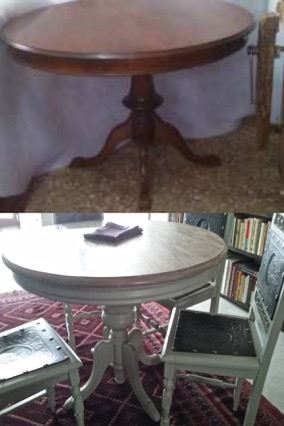 My most recent restoration project was our pedestal dining table. It was actually one of my easier restoration projects yet. It is not exactly a valuable antique, more like a typical dining table from the last century. And as everything here, it was stained brown. Not ugly, just a bit drab and a bit too ordinary for my taste. Once we got it brought to our house, I could hardly wait to revive it. I was up at the crack of dawn sanding the next day. Wishing the base to compliment our dining chairs, I primed and used the same antique taupe paint for the table base, then distressing it. I kept the table top natural, in spite of some past fillings and visual imperfections, just giving it a white wash, then a rub of grey tint to dirt it up, finally a layer of matte varnish and some white antiquing wax to protect it. I do not pretend to have made a master piece, but in the right light our dining set almost looks like a Gustaviansk setup in Stockholm’s Gamla Stan. With a Cordoba twist…
My most recent restoration project was our pedestal dining table. It was actually one of my easier restoration projects yet. It is not exactly a valuable antique, more like a typical dining table from the last century. And as everything here, it was stained brown. Not ugly, just a bit drab and a bit too ordinary for my taste. Once we got it brought to our house, I could hardly wait to revive it. I was up at the crack of dawn sanding the next day. Wishing the base to compliment our dining chairs, I primed and used the same antique taupe paint for the table base, then distressing it. I kept the table top natural, in spite of some past fillings and visual imperfections, just giving it a white wash, then a rub of grey tint to dirt it up, finally a layer of matte varnish and some white antiquing wax to protect it. I do not pretend to have made a master piece, but in the right light our dining set almost looks like a Gustaviansk setup in Stockholm’s Gamla Stan. With a Cordoba twist…
Of course, my restoration bug will not end here. My husband will likely never see his wife taking a cooking course, nor become a decent cook. There are too many antiques begging to be transformed and fixed. The world needs cooks and restorers. How else would those chefs be able to sit down to enjoy their meals?
(For restoration or design services, please contact me at www.snobb.net)
